|
|
Евразийская премия 2021 : Книга замечательных объектов = Eurasian Prize 2021 : Winners book. — Екатеринбург, 2021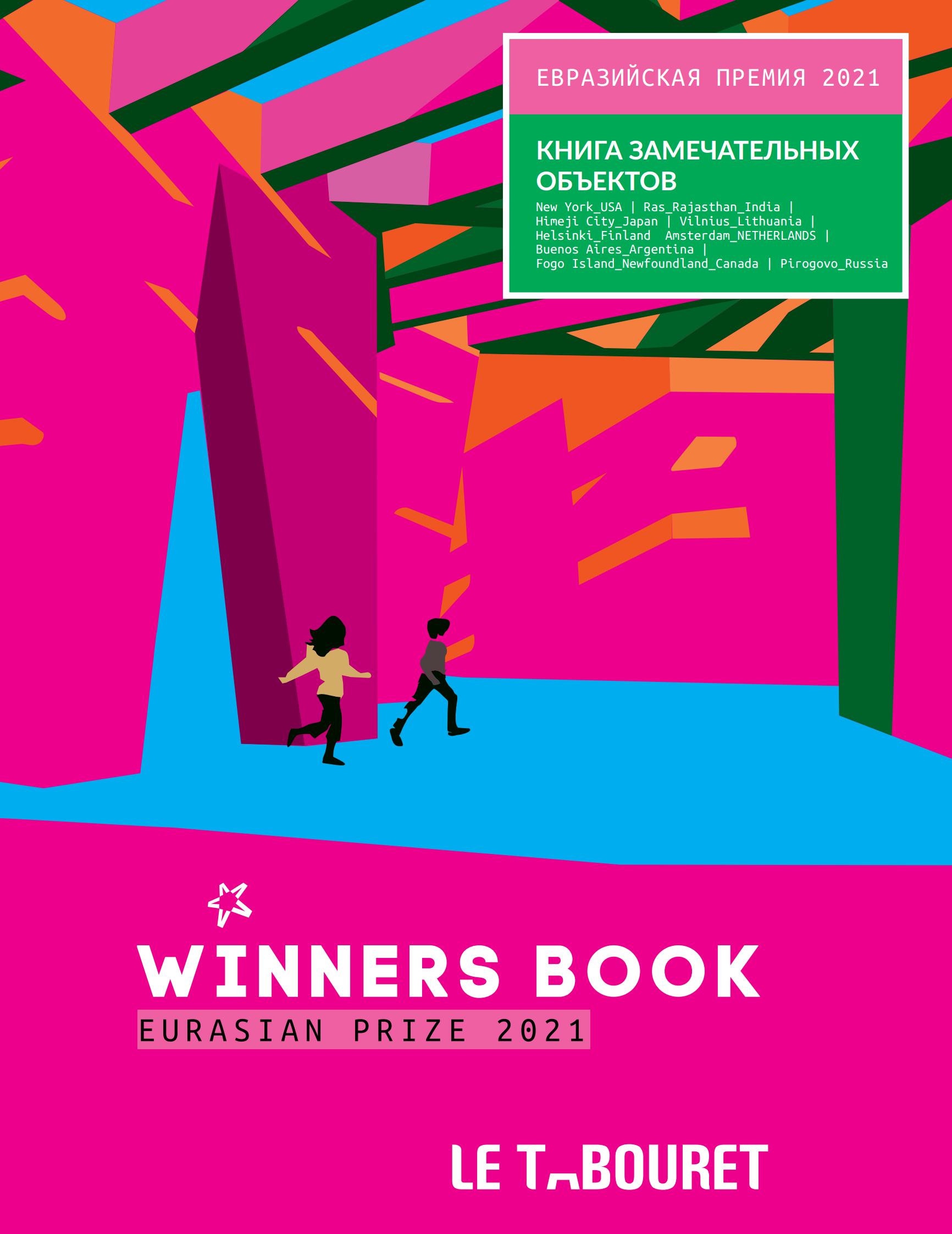 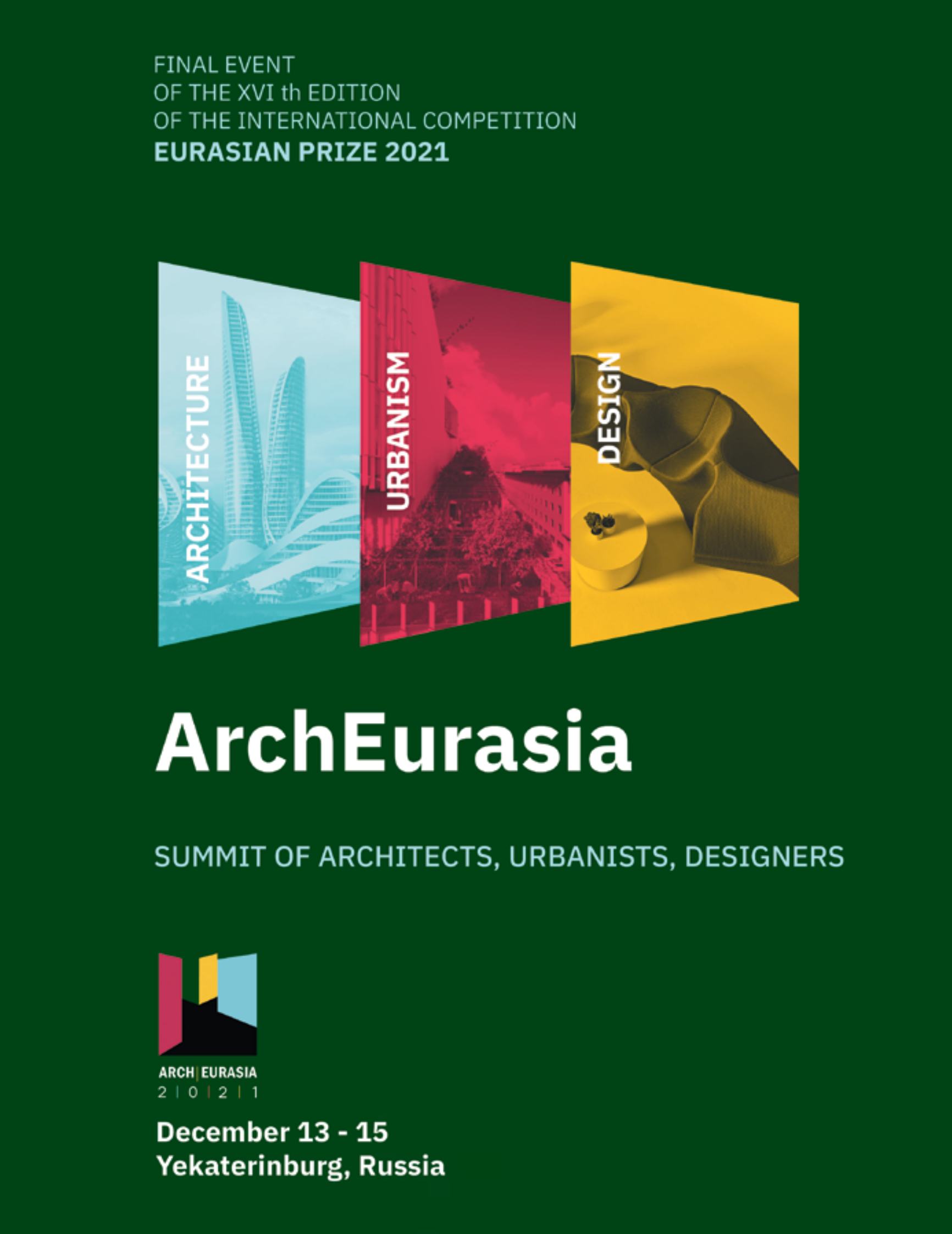 Евразийская премия 2021 : Книга замечательных объектов = Eurasian Prize 2021 : Winners book. — [Екатеринбург], 2021. — 197 с., ил.СОДЕРЖАНИЕ / CONTENT
PIERO LISSONI 004
Lissoni & Partners
Skylines 006
CRISTOS PASSAS 010
Zaha Hadid Architects 012
SANJAY PURI 016
THE RAJASTHAN SCHOOL 018
TETSUYA MATSUMOTO 022
KTX ARCHILAB
CLOUD OF LUSTER 024
JUHO GRÖNHOLM 028
ALA Architects
HELSINKI CENTRAL LIBRARY OODI 030
DANIEL LIBESKIND 036
MUSEUM VILNIUS 038
COSTAS VOYATZIS
Yatzerlab 042
YOSUKE HAYANO
MAD Architects 046
MIKKO SUMMANEN 048
k2S Architects
Helsinki Olympic Stadium 050
JEROEN SCHIPPER
Orange Architects 054
RODOLFO MACHADO 060
Machado Silvetti Building Z 062
TODD SAUNDERS 066
Saunders Architecture
FOGO ISLAND INN 068
FORMAFANTASMA
Rodolfo Machado / Machado Silvetti 074
ERICK VAN EGERAAT 076
Symbiosis with nature 078
COLIN SEACH
Ministry of Design 082
MICHEL ROJKIND 086
DORIANA MANDRELLI FUKSAS
Fuksas design 088
SYED FAWAD HUSSAIN
MSA 090
KEN YEANG 092
WINNERS BOOK
EURASIAN PRIZE 2021 097
ГАЛИНА БУКОВА, главный редактор журнала LeTabouret, директор Международной архитектурной Премии EURASIAN PRIZE, председатель фонда евразийских культурных проектов «АрхЕвразия», директор международного Саммита архитекторов, урбанистов, дизайнеров ArchEurasia.
— Уважаемые коллеги, дорогие читатели!
Редакция журнала LeTabouret с гордостью представляет вам очередной ежегодник — спецвыпуск WinnersBook 2021, посвященный итогам XVI сезона международного конкурса архитектуры и дизайна «Евразийская Премия 2021».
Текущий XVI-й сезон международной Премии по архитектуре и дизайну «Евразийская Премия» собрал участников из 22 стран. Конкурсанты представили на суд жюри объекты, расположенные в 29 странах и 46 городах мира. Отбор финалистов осуществляло Жюри, в состав которого вошли известнейшие архитекторы и дизайнеры из 16 стран.
В первой части нашего спецвыпуска мы представляем блестящий состав жюри и их проекты. Надеемся, что эти вдохновляющие проекты не оставят вас равнодушными. Вторая часть посвящена работам, получившим призовые места в XVI-м конкурсном сезоне «Евразийская Премия 2021».
Мы искренне поздравляем всех призеров, благодарим участников конкурса и уважаемых членов международного жюри. Желаем всех новых творческих озарений и благоприятных условий для их осуществления.
Присоединяйтесь к нашим поздравлениям!
GAINA BUKOVAEditor-in-chief of LeTabouret magazine, chairman of the "ArchEurasia" Foundation for Eurasian Cultural Projects, CEO of the International Summit of architects, urbanists, designers "ArchEurasia" and the International Architectural Award "EURASIAN PRIZE".
Dear colleagues, dear readers!
The editorial team is proud to release the annual LeTabouret magazine — the special issue WinnersBook 2021, dedicated to the results of the 16th issue of the international competition for architecture and design Eurasian Prize 2021. Competitors from 22 countries took part in the current season of the 2021 Eurasian Prize. The contestants presented their projects located in 29 countries and 46 cities of the world. The projects were scored, and the winners were selected by an international jury, which included world-famous figures of architecture and design from 16 countries. The first part of the magazine reviews the projects of the members of the international jury. We hope that the inspiring design projects will impress you. The second part focuses on the winners’ projects of the 16th issue of the Eurasian Prize 2021. Congratulations to the winners, thanks to the distinguished members of the international jury and everyone who joined in the competition! We wish you new achievements, creative ideas, and favorable conditions for their implementation!
АНДРЕЙ БОКОВ, Президент Московского отделения (МААМ), вице-президент Международной академии архитектуры (IAA), председатель оргкомитета Международной архитектурной Премии EURASIAN PRIZE.
— Меня часто спрашивают, в чём заключается миссия архитектора. Я думаю, что в этой творческой профессии, как и в любой другой, есть люди — миссии, осознающие свою роль, сверхзадачу, ответственность перед будущим. Каждый сам придумывает свою программу, но людей — миссионеров, визионеров, тех, кто заражен идеями и раздвигает границы даже себе в ущерб — немного. Общество заинтересовано в развитии архитектуры, в появлении визионеров новых образов. Без новых талантов развитие архитектуры невозможно, поддержка талантов важна и нужна. Талантливые есть всегда, но сегодня во многих странах сложился рынок проектных услуг, подчиненный интересам заказчика, в который сложно войти не только молодым архитекторам, но и принципиальным профессионалам, если только ты не «звезда». Профессиональный отбор, наращивание профессионального авторитета проходит именно через систему открытых смотров-конкурсов специалистов, а молодежные конкурсы часто являются пропуском в профессию архитектора. Конкурсы, которые сегодня проводятся в России, большей частью закрытые. Тем ценнее «Евразийская Премия», и всё, что с нею связано. «Евразийская Премия», являясь глобальной инициативой, направлена на выявление и поощрение талантливых архитекторов, градостроителей и дизайнеров, а также, продвижение инновационных проектов, продуктов и практик, меняющих мир. В своём роде, это единственный на постсоветском пространстве, да и во всей Евразии формат, где встречаются Восток и Запад. Сегодня, спустя 18 лет со дня основания, «Евразийская Премия» представляет собой целый парад мероприятий — архитектурный марафон «АрхЕвразия». Это уже не только международный конкурс, но и фестиваль, форум, саммит архитекторов, урбанистов, дизайнеров, открытые для междисциплинарного диалога. На мой взгляд, организаторы этой масштабной всеобъемлющей дискуссионной площадки поставили перед собой актуальную интересную задачу выявлять и культивировать самые инновационные идеи, а также выработать конкретные решения, которые смогут стать ответом на современные вызовы.
ANDREY BOKOVPresident of the Moscow Branch (MAAM), Vice President of the International Academy of Architecture (IAA), Chairman of the Organizing Committee of the International Architecture Award "EURASIAN PRIZE".
I am often asked what the architect’s mission is about. I think, like in any other area, in this creative profession, there are mission people who are conscious of their role, super-objective, and responsible for the future. Each one conceives of their program, but there are very few people who are missionaries, visionaries, who are infected with ideas and push the limits, even if they have to pay a price. Society is interested in the development of architecture and the emergence of visionaries with novel images. Architectural development is impossible without new talents, and it is essential to support talents. There are always talents, but today in many countries the market of design services is subordinated to customer interests, in it is very difficult to enter this market not only for young architects but also for a professional of principle unless you are a «star». Professional reputation buildup occurs exactly through the system of open specialist review while competitions among young talents are often is a pass into the architectural profession.
This attaches high value to the Eurasian Prize and everything related to it. Being a global initiative, the Eurasian Prize is aimed at identifying and encouraging talented architects, urban planners, and designers and at promoting innovative projects, products, and practices that change the world. It is the only format in the post-Soviet space and, in fact, in Eurasia in which East and West are brought together. Today, 18 years since the year of its foundation, the Eurasian Prize presents are whole ‘parade’ of activities — the ArchEurasia architectural marathon. This is no longer just an international competition, but also a festival, forum, and summit of architects, urban planners and designers open for an interdisciplinary dialogue. In my view, the organizers of this large-scale comprehensive discussion platform have set themselves an exciting goals to identify and cultivate most innovative ideas and work out specific solutions that may become an answer to contemporary challenges.
Cristos Passas / zaha hadid architects
Кристос Пассас — ведущий архитектор и исполнительный директор бюро Zaha Hadid Architects. Кристос присоединился к Zaha Hadid Architects в качестве старшего дизайнера в феврале 1998 года и стал ключевым участником общей художественной эволюции студии, развития ее бизнеса, офисной культуры и лидером широкого спектра строительных и строительных проектов и конкурсов в рамках практика.
Кристос преподавал параметрический дизайн и урбанизм в Архитектурной ассоциации с Патриком Шумахером в Лондоне в период с 2007 по 2010 год, работая над исследованием цифровых и параметрических методов для формирования крупных городских поселений.
Впоследствии он продолжал работать в качестве приглашенного профессора DAAD в Институте архитектуры Дессау в Баухаусе, Дессау, с 2008 по 2012 год, работая над реализацией стратегий цифрового дизайна для крупномасштабных объектов со сложной геометрией и характером, исследуя уникальность и разнообразие. В настоящее время он является почетным профессором Технологического университета, Колледжа архитектуры и городского планирования Циндао до 2022 года.
Cristos Passas, Design Director at Zaha Hadid Architects, BArch (Hons), AA Grad.Des.ip, RIBA, ARB, ETEX. Cristos joined Zaha Hadid Architects as a Senior Designer in February 1998 and has been a key member in the development of the overall artistic evolution of the Studio, it’s business development, the office culture, and leader of a wide range of build and unbuilt projects and competitions within the practice. Christos taught Parametric Design and Urbanism at the Architectural Association with Patrik Schumacher in London between 2007 and 2010, working on the exploration of digital and parametric techniques for the formation of large urban settlements.
He subsequently went on to serve as Guest DAAD Professor in the Dessau Institute of Architecture (HA) at Bauhaus, Dessau, from 2008 to 2012 working on the implementation of digital design strategies for large-scale objects with complex geometry and character, exploring uniqueness, diversity, and complexity. He is currently an Honorary Professor at the University of Technology, College of Architecture and Urban Planning of Qingdao until 2022.
«Архитектура должна находиться в авангарде прогрессивного мышления»
Кристос Пассас, исполнительный директор Zaha Hadid Architects, член жюри 16-го сезона конкурса Eurasian Prize в эксклюзивном интервью о профессии, трендах и архитектурных конкурсах.
— Изменились ли ваши подходы в работе (как в организации процессов внутри ZHA, так и в работе над архитектурными проектами) после локдауна в связи с C0VID-19? Какие новые тренды в мировой архитектуре появились под влиянием пандемии?
— Пандемия C0VID-19 очевидно принесла ряд серьезных изменений. Например, наш офис стал почти «виртуальным», и в эти дни многие сотрудники работают в основном из дома. Несложно представить, что создание дизайна, коммуникация и работа в команде сейчас происходит по-другому. Но это не означает, что культура и дух офиса изменились, люди проявили удивительную гибкость и быстро адаптировались к новым формам взаимодействия. На самом деле существует реальная человеческая потребность в общении, и эта потребность позволила людям во всем мире перестроиться и адаптироваться к новым условиям. Что касается изменений в глобальной перспективе, я отмечу, что люди как никогда стали ценить общение, они стали уделять больше внимания качеству жизни, больше беспокоятся по поводу окружающей среды. Поэтому, несмотря на негативные моменты, произошло много позитивных, прогрессивных изменений, и я чувствую, что это изменения к лучшему.
— У вас одно из самых известных архитектурных бюро. Многие молодые архитекторы мечтают получить опыт работы в вашей команде. Как вы подбираете новые кадры, и какими навыками должен обладать успешный кандидат для сотрудничества с Zaha Hadid Architects?
— Я думаю, что наша работа всегда требует дополнительных усилий. Есть расхожая фраза о том, что «если кто-то хочет легкой жизни, то он не должен становиться архитектором». Тем не менее, есть много квалифицированных молодых специалистов, которые проявляют драйв, решимость и приверженность практике архитектуры. Тип людей, с которыми мы хотим работать — это люди с твердым характером, развитым «чувством архитектуры», готовые генерировать и исследовать новые идеи, не останавливаться и всегда стремиться сделать лучше.
— В каких странах сегодня особенно высок запрос на современную архитектуру?
— По моему мнению, страной, которая сегодня стимулирует дополнительный спрос, несомненно, является Китай. Однако значительные изменения в плане технологических достижений или архитектурного мышления происходят во многих странах. На мой взгляд, основной запрос сегодня связан с интеграцией экологии и технологий. Идет ли речь о крупных городских застройках, о проектировании микрорайонов или даже отдельных зданий, необходимо определять реальные цели в области устойчивого развития и дизайна, ориентированного на человека.
— Чем этот запрос обусловлен? Это ответ на глобальные тенденции, запрос общества?
— Архитектура должна находиться в авангарде прогрессивного мышления и всегда учитывать современные вызовы, с которыми сталкиваются города. Города сегодня требуют преобразования среды, повышения качества жизни, адаптации к новым технологиям и обеспечения доступности, а также повышения уровня жизни, образования, работы и социальных свобод на постоянной основе.
— ZHA большое внимание уделяет вопросам устойчивого развития и экологии. Кто занимается экспертизой зеленых технологий и вопросами их применения в ваших проектах — это сотрудники, или подразделения внутри бюро, или привлеченные специалисты, сторонние компании, исследовательские институты?
— Мы постоянно пробуем новое, экспериментируем, тестируем, проверяем, затем оцениваем и внедряем, затем проверяем снова. Это постоянный процесс обучения и игры с самыми различными средствами, которые могут воплотить архитектурные идеи. Да, мы работаем с широким кругом консультантов или специалистов, но у нас есть и «внутренние» подразделения, которые специализируются в области программирования, анализа окружающей среды, фасадов, городского планирования, различных типов зданий, инфраструктуры и так далее. У нас обширная структура развития и широкая сфера деятельности, которые дают нам возможность осуществлять многие исследования.
— По каким принципам и критериям вы выбираете те или иные технологии, которые в перспективе используете для создания инновационных проектов?
— Технологии постоянно меняются. В этом смысле речь идет не столько о выборе технологий, сколько о конкретных методах. Их мы оцениваем с точки зрения жизнеспособности и полезности. Успех зависит от того, позволяют ли они переосмыслить и подойти к решению старой задачи с новой точки зрения.
— Что вы можете сказать о миссии архитектуры в 2021 году, в чем она заключается лично для Вас? Какие за дачи важно решать сегодня в рамках профессии?
— Для меня задача архитектуры и в 2021 году, и в будущем заключается в развитии экотехнологической среды обитания. Я говорю о развитии профессионального представления о том, какими должны быть живые экосистемы. Они должны учитывать не только деятельность человека, но и принимать во внимание природные ритмы в экологии. И развиваться с учетом гармоничного взаимодействия этих двух факторов: человека и природы.
— Вы вошли в состав жюри Евразийской Премии в этом году. Что, на ваш взгляд, дают независимые конкурсы архитектурному профессиональному сообществу? И могут ли подобные мероприятия быть интересны широкой публике? Если да, то почему?
— Я считаю, что роль архитектурных конкурсов чрезвычайно важна. С одной стороны, у участников есть шанс предложить решения, пусть даже самые нестандартные и радикальные, которые могут обогатить и продвинуть архитектурную мысль и дискурс архитектуры за пределы академических кругов и официальных учреждений.
Публикация конкурсных проектов — это тоже увлекательно, потому что доступ к работам получает весьма широкий круг людей. По сути, у этих людей появляется возможность увидеть новую точку зрения архитектуры. Но авторам, разумеется, необходимо тщательно и четко разъяснять архитектурные решения, с тем чтобы не допустить их искаженного понимания в непрофессиональной среде. И в этом контексте важна роль «теоретиков» — людей, которые могут рассказать о проекте так, чтобы преодолевался «понятийный» разрыв между архитектурным чертежом и его реальным воплощением; так, чтобы это было понятно большинству людей.
— У Вас есть возможность обратиться к участникам конкурса «Евразийская Премия». Что бы вы им хотели посоветовать или пожелать?
— Желаю, чтобы все нашли в себе смелость выдвинуть свои самые искренние проекты, которые покажут умение мыслить нестандартно и смотреть на вещи под разными углами. Помните, что важен вклад каждого. Я желаю всем удачи и больших успехов!
“CONTEMPORARY ARCHITECTURE MUST BE AT THE FOREFRONT OF PROGRESSIVE THINKING”.
CHRISTOS PASSAS, CEO OF ZAHA HADID ARCHITECTS, JURY MEMBER OF THE 16TH SEASON OF THE EURASIAN PRIZE, ABOUT PROFESSION, TRENDS AND COMPETITIONS.
— Have your approaches changed (both in the organization of processes within ZHA and in the work on architectural projects) after lockdown and COVID-19? What new trends in global architecture would you note as being influenced by a pandemic?
Certainly, there have been several changes that came out of this pandemic. For example, our office has become mostly “virtual” these days and people are working mostly from home. One can imagine that the interactions, collaborations, and also design creation is happening in a different way now.
That is not to say that the culture and ethos of the office have changed. It was that people have shown agility and have adapted to the new means of working.
There is a real human need to interact and interrelate and people globally were proactive to adapt and to be able to make the most of the new situation.
In terms of the global outlook, we have observed that people are now more interested in the quality of life, better interactions, more sensitivity about the environment. So despite the negatives, there have been a lot of positive, progressive changes and I feel it is for the better.
— You have one of the most famous the bureau, including the general public outside of the professional community. Many students and young architects dream of gaining experience in your team. How you are selecting new frames and what skills a successful candidate should have for collaboration with Zaha Hadid Architects?
I think the work that we do always takes an extra effort. We often spoke about the idea that “if one wants an easy life then they shouldn’t become an architect”. That said there is a lot of skilled young professionals out there and also people who show drive, determination, and commitment to the practice of architecture. These are the types of people that we want to work with. Working, with a strong ethos and good architectural sensibilities being willing to explore new ideas, and always work to improve.
— Your bureau works all over the world, please, in which countries do you think the demand for modern architecture is particularly high today?
I think the country that drives the additional demand today is undoubtedly China however there are many other countries where significant developments are happening in terms, for example, of technological advancements or in terms of architectural thinking. The main issues today have to do, in my opinion, with the integration of ecology and technology. Whether In large urban developments or in designing micro-districts or even buildings there is a need now to establish tangible sustainability targets and human centric design.
— What is the reason for this request? Is it a response to global trends, societal demands, favourable political or economic conditions?
Contemporary architecture must be at the forefront of progressive thinking and always engage with the current challenges cities are facing. Cities demand the transformation of the urban environments, upgrading the quality of life, adapting to the new technologies and making those accessible, improving standards of living, education, work, and social liberties in a sustainable manner.
— ZHA focuses on sustainable development and ecology. Who examines green technologies and their application in your projects — employees or units within the bureau or external specialists, external companies, research institutes?
We constantly experiment, do tests, review then assess and implement, review. It’s a constant learning process and playing with the different means through which — architectural ideas can be applied. We work with a wide variety of consultants or specialists and we also have “in-house” units that specialize In the fields of programming, environmental analysis, facades, urban planning, varied building typologies, infrastructure et cetera. We have a very broad development structure and also a very wide base of activities that give us the opportunity to share and implement a lot of our research.
— Can you tell us more about the principles and criteria by which you select the technologies or technologies that you will eventually use to create innovative projects?
Technology is an ever-changing constant. In that sense, it’s not so much about the selection of technologies but of particular methods. Their success depends on their viability and their usefulness, how it enables us to rethink and approach an old challenge from a new angle.
— In June you signed a partnership agreement with Hyperloop Italia. Can you tell us more about ZHA’s involvement? There’s a lot of skeptics around the world about the future of this technology, so tell me, why do you believe in this project? How soon will Hyperloop become a reality?
As I understand Hyperloop is interested in developing components and sections or terminals for the expansion of their system. ZHA’s collaboration is aimed at developing some key elements of this system and can be an important partner in this endeavor.
— What can you say about the mission of architecture in 2021, what is it for you personally? What is the importance of solving today within the profession?
For me, the role of architecture in the year 2021 and beyond is to develop the eco-technological habitat. That is to develop extended notions of how living ecosystems should be, by taking into account the human activities but also the rhythms of nature in the ecology and bringing the two in harmonious unison.
— You’re on the jury for the Eurasian Prize. In your opinion, what do independent competitions give to the architectural professional community? Can these formats be of interest to a layman? If so, why?
I think the role of architectural competitions is extremely important. On one hand, the contestants have a chance to propose solutions, radical as they may be, that can enrich and push forward architectural thought and the discourse of architecture beyond the bounds of academia and formal institutions.
The publication of the results can also be a very engaging process, as it offers the possibility of direct access into the works and essentially what can be possible in architectural terms.
Of course, certain solutions need to be explained carefully and clearly so that they are not misunderstood. In that sense, the role of theorists is important because they can help bridge the gap between an architectural drawing and the presentation of the results in a way that can be understood by most people.
— In conclusion, do you have the opportunity to address the participants of the Eurasian Prize Contest, which would you like to advise or wish them?
I would wish that everybody find the courage to propose their most genuine proposals. To think outside the box and to look at things from different angles. Everyone’s contribution is important. I wish everybody good luck and great success!
Примеры страниц / Sample pages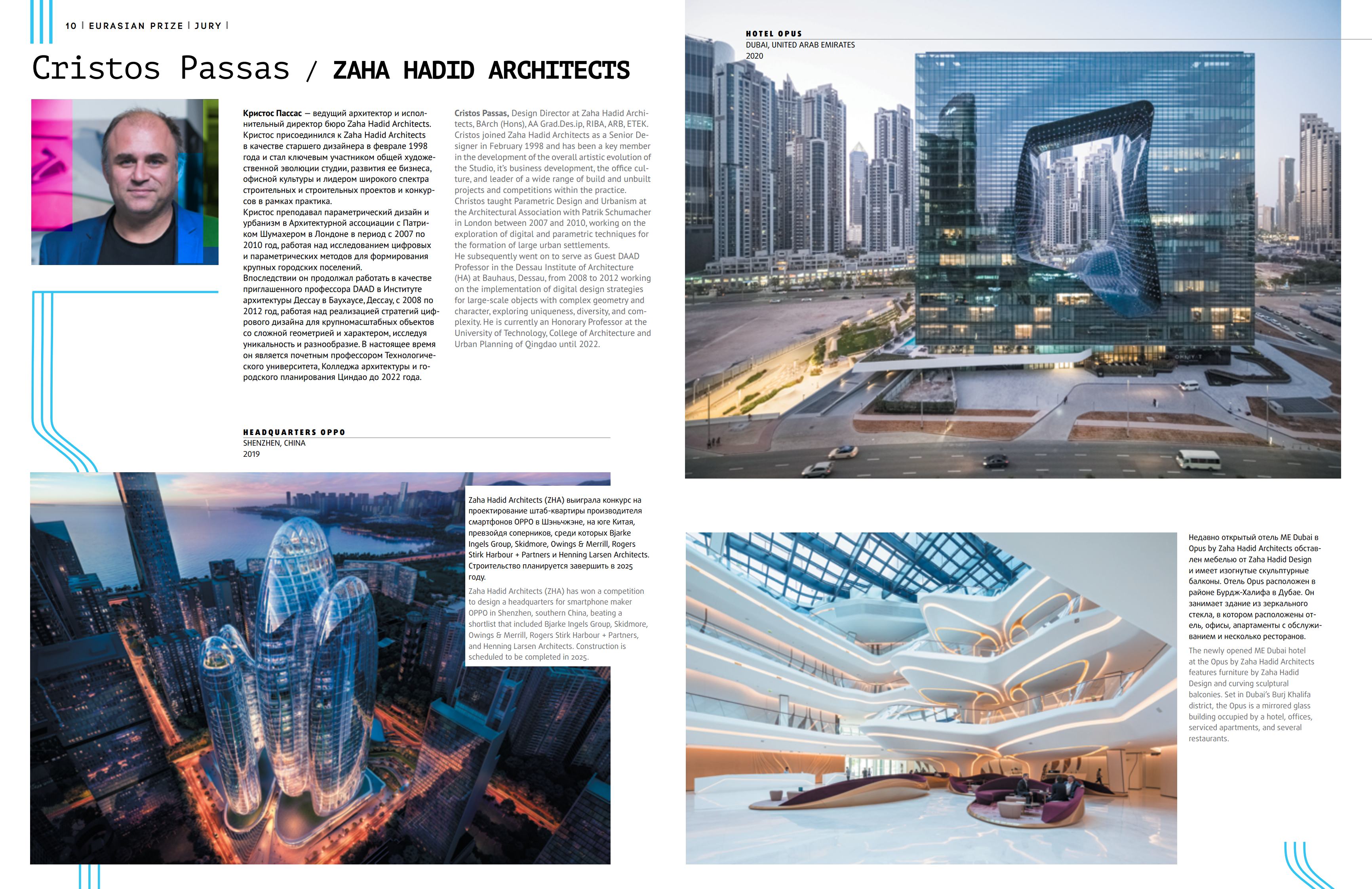 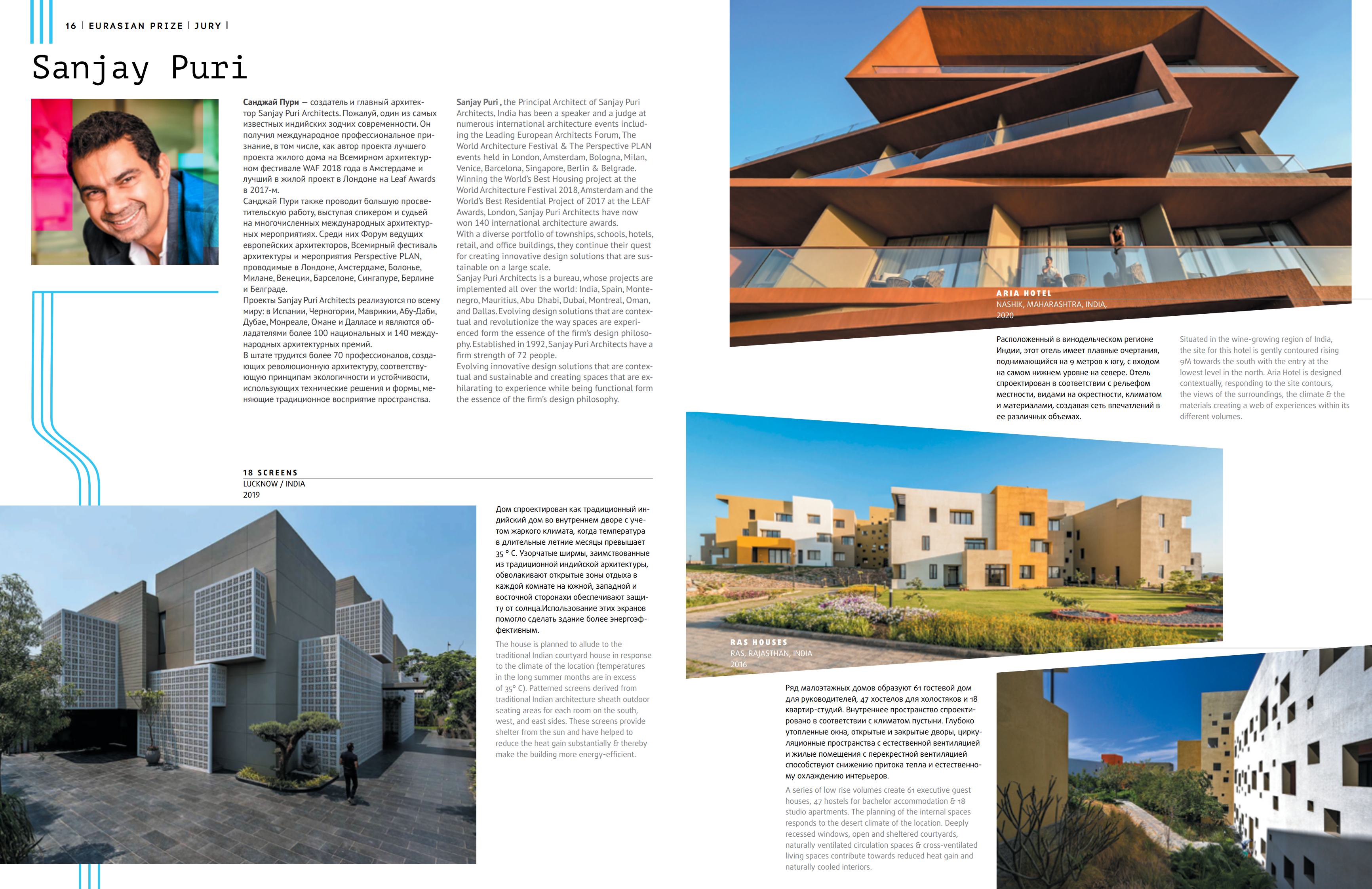 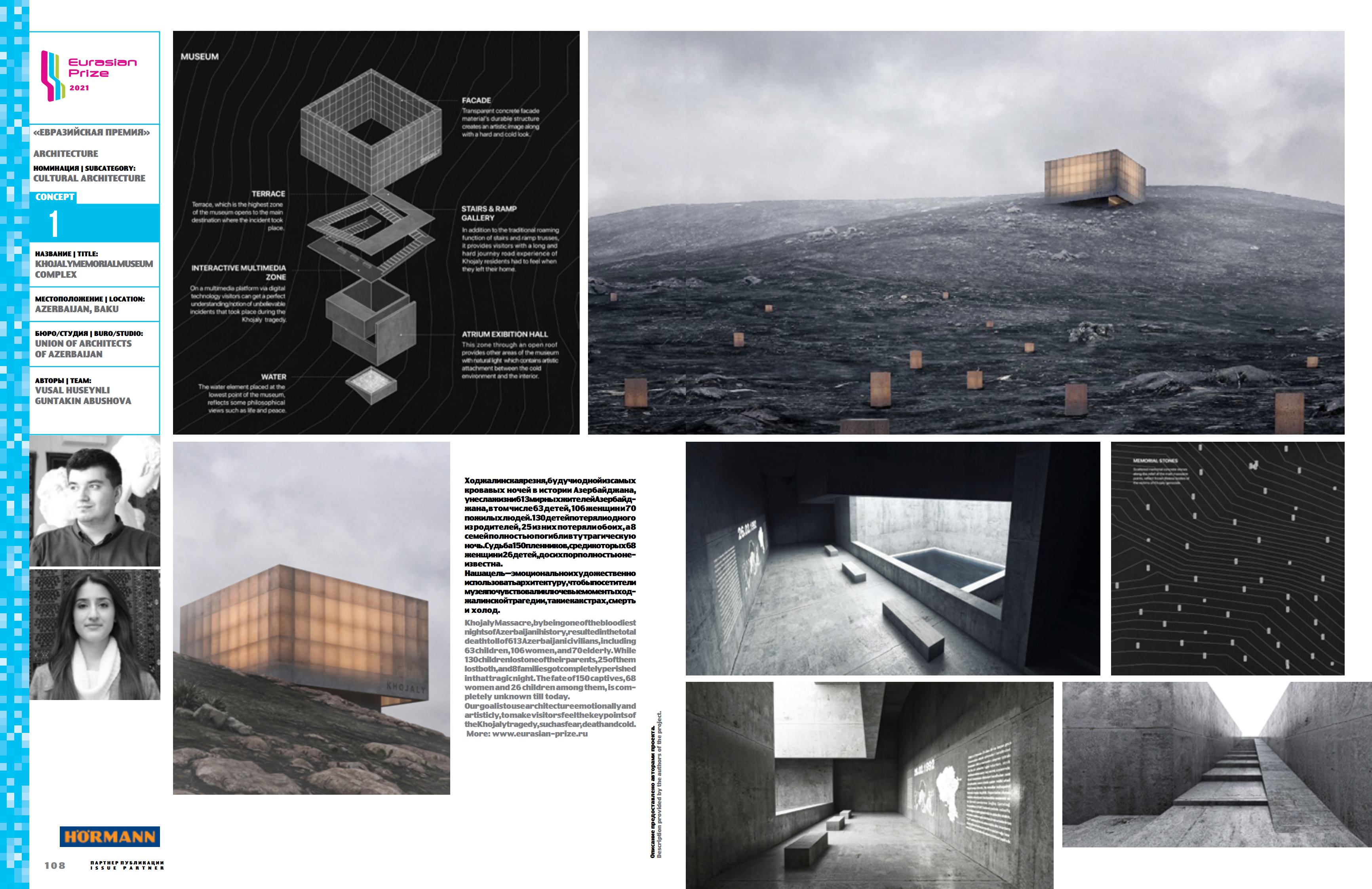 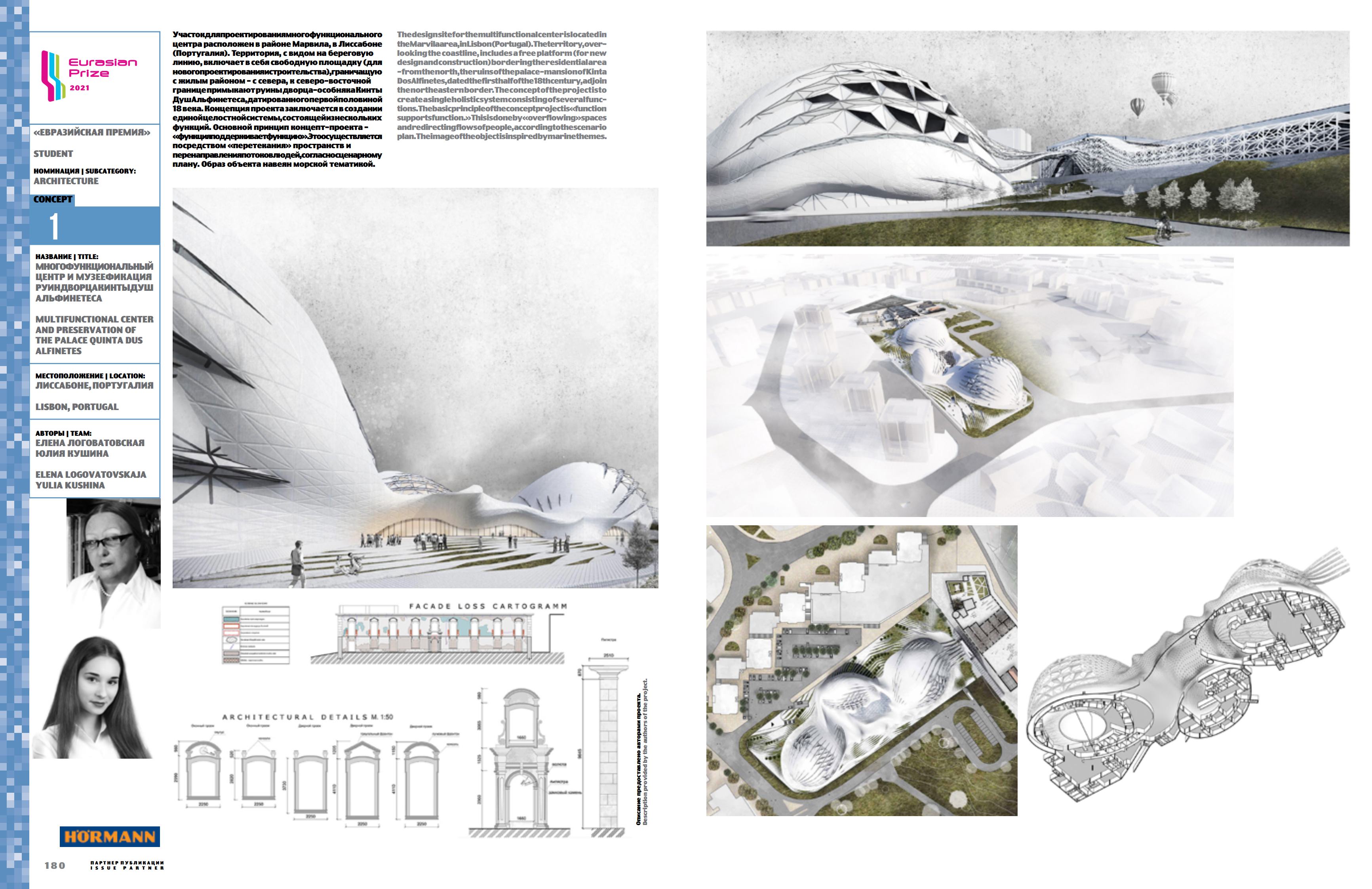
Скачать издание в формате pdf (яндексдиск; 97,7 МБ).
Download link (pdf, yandexdisk; 97,7 MB).
26 декабря 2021, 14:35
1 комментарий
|
Партнёры
|






Комментарии